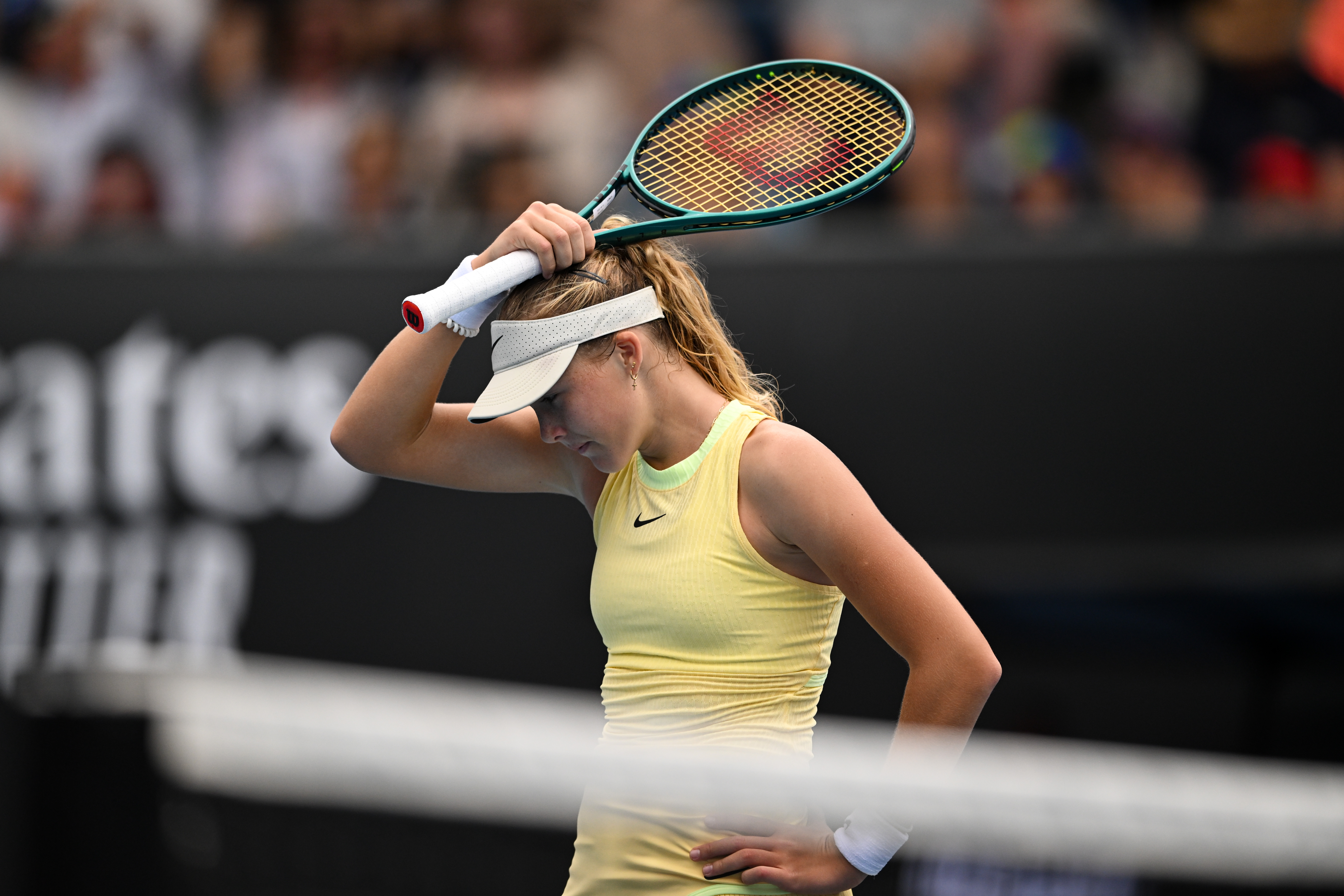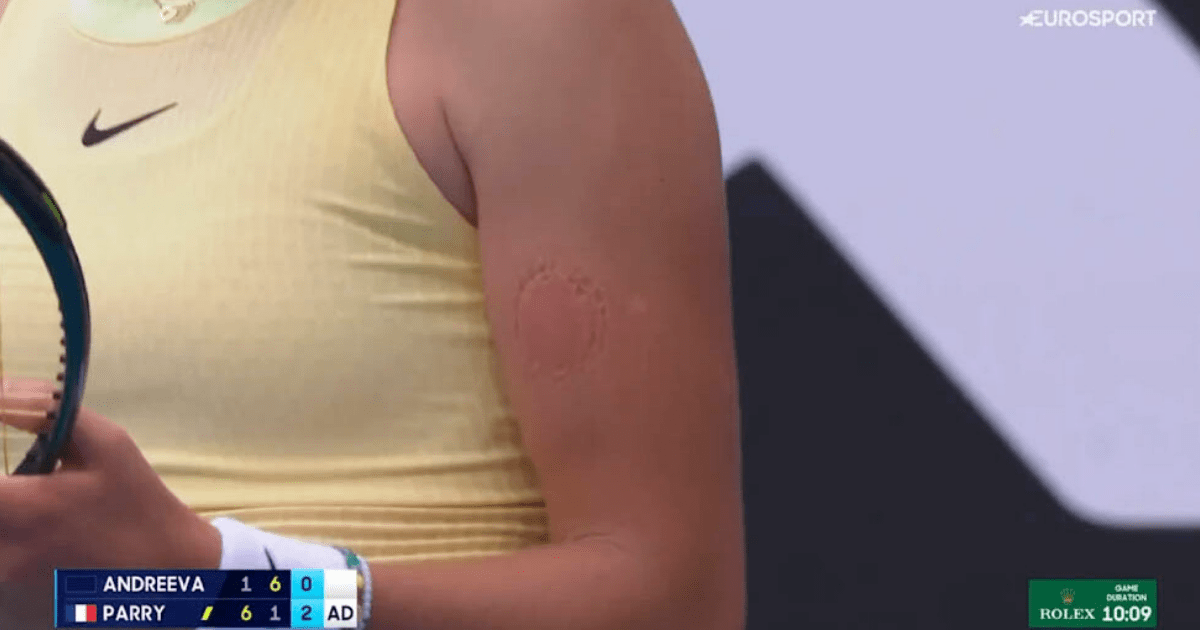Young tennis sensation Mirra Andreeva left fans shocked after she appeared to bite her own arm during a heated match at the Australian Open.
Rising Star
Despite the incident, the 16-year-old has been making waves in the tournament.
Andreeva displayed visible bite marks on her arm
Andreeva showcased her determination during the match
She went on to secure a straight sets victory
After reaching the girls' singles final last year, Andreeva is making an impact in the women's event this time around.
Following her straight sets win against Bernarda Pera in the first round, Andreeva dominated fifth seed Ons Jabeur in a 6-0, 6-2 demolition.

She aimed to continue her impressive performance against world No.72 Diane Parry.
Parry took the first set 6-1, but Andreeva fought back, winning the second set 6-1 to level the match.
During the decider, Andreeva fell behind and became visibly frustrated with herself.
In a surprising turn of events, Andreeva displayed bite marks on her own arm.

Although she found herself trailing 5-1, Andreeva showed incredible resolve, clawing her way back to win the match 10-5 in a deciding tiebreak.
The young star is a big fan of Andy Murray and has previously praised him in interviews.
While watching Andreeva's latest match, Murray defended her when a commentator questioned her mental strength during the third set.
Murray, who was eliminated in the first round by Tomas Martin Etcheverry, tweeted: "Andreeva down 5-1 in third. Commentator: 'She really needs to work on mental side of her game… she's too hard on herself when she's losing.' 30 minutes later 7-6 Andreeva wins.

"Maybe the reason she turned the match round is because of her mental strength.
"Maybe she turned the match around because she is hard on herself and demands more of herself when she's losing/playing badly? Winner."
When Andreeva was informed about Murray's tweet in her post-match press conference, she was overjoyed and said she would print it out and frame it.
Talking about her mentality, Andreeva said: "Maybe being harsh on myself actually helped me.
"I just try to think positively. This harshness, let's say, helped me with it because I am not very positive in my head usually. I just kept pushing myself. I was saying not good words to myself. I think that helped me, that pushed me."
Andreeva will face former French Open champion Barbora Krejcikova in her next match on John Cain Arena.
Frequently Asked Questions
What is the uniqueness of tennis’ scoring system?
Tennis has a unique scoring system that contributes to its character. Matches are divided into sets and games, with players needing to win six games by a margin of two to claim a set. In games, scoring goes from love (0), to fifteen (30), and forty (40), before the winner is determined. When players reach deuce, (tied at 40), they need to win by 2 consecutive points. This system is unpredictable and creates tension.
What has been the impact of women on tennis?
Women have shaped tennis significantly, both through on-court performances and off-court advocacy for equality and recognition. Billie Jean King’s effort to promote equal prizes and professional opportunities among women was the main reason for the Women’s Tennis Association’s formation in 1973. Steffi Graf and Venus and Serena Williams along with Martina Navratilova, all icons in the sport, have raised its profile dramatically through their talent and competitiveness. Furthermore, women’s tennis often commands equal viewership, highlighting the sport’s inclusivity and appeal across genders.
What role has tennis icons played in the popularization of the sport?
Tennis icons played a crucial role in the globalization of tennis. Throughout its history, charismatic and skilled players like Billie Jean King, Rod Laver, Bjorn Borg, Martina Navratilova, Pete Sampras, Serena Williams, and Roger Federer have captured the public’s imagination. The achievements of these players on the tennis court and their personalities away from the court not only inspired fans but also younger generations to pick up the sport. Their legacy goes beyond their titles and has shaped the culture and market of tennis.
What are the historical roots of tennis?
Tennis has its origins in the 12th century France. Monks used their hands to hit a ball called jeu de paume, which was played on courtyards of monasteries. With time, rackets came into play, and tennis evolved. The game was popularized by the European nobility in the 16th century. Tennis has changed a lot since it was first invented, with the introduction in the 19th Century of lawn tennis and standardized rules.
How has tennis equipment evolved over the years?
Tennis equipment has undergone significant evolution since the game’s early days. Original rackets were made of solid wood with string gut made from animal intestines. The technology has improved over time, introducing new materials like titanium, carbon fiber, and graphite. This makes rackets lighter, stronger, and more durable. The balls themselves have changed as well, from being hand-sewn into manufactured rubber pressurized balls which provide consistent bounce. This has led to a more athletic and dynamic form of play.
Statistics
- Lawn tennis, which evolved into the game we know today, adapted its point system from the jeu de paume, with theories suggesting its increments represent the face of a clock.
- The International Tennis Federation (ITF) governs over 200 nations, indicating the sport’s vast international governance structure and participation rate.
- The global tennis equipment market reached an estimated value of over 1 billion dollars, reflecting the sport’s widespread popularity.
- Since the Open Era began in 1968, allowing professional players to compete in the Grand Slams, the United States has produced the most Grand Slam singles titles across men’s and women’s competition.
- The modern game of tennis originated in England in the late 19th century, with the first Wimbledon Championship held in 1877.
External Links
usta.com
smithsonianmag.com
wimbledon.com
rolandgarros.com
tennis.com.au
How To
Tennis Shoes: How to Choose the Right Shoes for your Court Surface
Tennis shoes are chosen according to what type of court you play on. Hard court players need durable soles to handle abrasive surfaces. Clay court shoes are often designed with herringbone treads for maximum grip and control. Grass court footwear often has nubs or a pimpled bottom to give traction and not damage the court. To avoid injury and to improve your movement on the courts, make sure you have the right fit and support.

